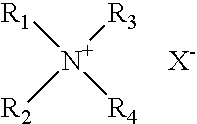Wood preservative compositions
a technology of preservative composition and wood, which is applied in the direction of biocides, manufacturing tools, paints, etc., can solve the problems of high copper leaching from the treated wood, affecting the appearance of the treated wood, and affecting the use of ammonia as a copper-solubilizing agen
- Summary
- Abstract
- Description
- Claims
- Application Information
AI Technical Summary
Benefits of technology
Problems solved by technology
Method used
Image
Examples
example 1
[0100]20 pieces of the commercially used incised hem fir lumbers with a nominal size of 2″×6″×8′ were used in the current study. Prior to the pressure impregnation, each piece was cut into two 4-foot sections. As a result, 2 sets of hem fir samples with matched pieces were generated, and each set was used in the following treatment.
I A—Treating the Hem Fir with Fine Copper Particle Dispersion
[0101]A wood preservative treating liquid containing 0.35% CuO and 0.35% didecyldimethylammonium carbonate / bicarbonate (Quat) was prepared by mixing water with a Quat concentrate and a concentrate of copper carbonate particle dispersion with mean particle size less than 0.25 microns. The treating liquid was used to treat one set of hem fir samples with a modified full cell treating schedule including 30 min initial vacuum at 27-inch Hg, 2 hour pressure at 190 psi, and 20 minutes final vacuum at 27-inch Hg. After treatment, the borings were taken for measuring copper penetration. The penetration ...
example 2
[0103]20 pieces of the commercially used red pine lumbers with a nominal size of 2″×6″×8′ were used in the current study. Prior to the pressure impregnation, each piece was cut into two 4-foot sections. As a result, 2 sets of red pine samples with matched pieces were generated, and each set was used in the following treatment.
II A—Treating the Red Pine with Fine Copper Particle Dispersion
[0104]A wood preservative treating liquid containing 0.20% CuO and 0.20% didecyldimethylammonium carbonate / bicarbonate (Quat) was prepared by mixing water with a Quat concentrate and a concentrate of copper carbonate particle dispersion with mean particle size less than 0.10 microns. The treating liquid was used to treat one set of red pine samples with a modified full cell treating schedule including 30 min initial vacuum at 27-inch Hg, 1.5 hour pressure at 190 psi, and 40 minutes final vacuum at 27-inch Hg. After treatment, the borings were taken for measuring copper penetration. The penetration t...
example 3
[0106]20 pieces of the commercially used red pine lumbers with a nominal size of 2″×6″×8′ were used in the current study. Prior to the pressure impregnation, each piece was cut into two 4-foot sections. As a result, 2 sets of red pine samples with matched pieces were generated, and each set was used in the following treatment.
III A—Treating the Red Pine with a Conventional Copper Formulation Containing Amine Copper Quaternary (ACQ-D)
[0107]A wood preservative treating solution containing 0.27% CuO and 0.13% didecyldimethylammonium carbonate / bicarbonate (Quat) was prepared by mixing water with a Quat concentrate and a Cu-amine solution concentrate. The treating solution was used to treat one set of red pine samples with a modified full cell treating schedule including 30 min initial vacuum at 27-inch Hg, 1.5 hour pressure at 120 psi, and 20 minutes final vacuum at 27-inch Hg. After treatment, the borings were taken for measuring copper penetration. The penetration test was conducted i...
PUM
| Property | Measurement | Unit |
|---|---|---|
| Fraction | aaaaa | aaaaa |
| Fraction | aaaaa | aaaaa |
| Fraction | aaaaa | aaaaa |
Abstract
Description
Claims
Application Information
 Login to View More
Login to View More - R&D
- Intellectual Property
- Life Sciences
- Materials
- Tech Scout
- Unparalleled Data Quality
- Higher Quality Content
- 60% Fewer Hallucinations
Browse by: Latest US Patents, China's latest patents, Technical Efficacy Thesaurus, Application Domain, Technology Topic, Popular Technical Reports.
© 2025 PatSnap. All rights reserved.Legal|Privacy policy|Modern Slavery Act Transparency Statement|Sitemap|About US| Contact US: help@patsnap.com

